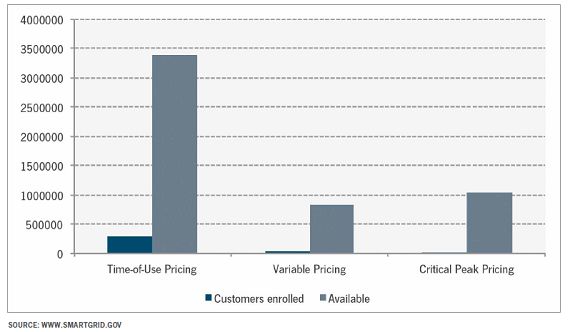Earlier this month we discussed the factors driving the grid edge market. This week, in another excerpt from our free Grid Edge report, we look at the current challenges and gaps facing the industry.
Several impediments may limit the growth of the grid edge market. They can be grouped into four broad categories: regulatory, technological, business, and information gaps.
Regulatory Challenges and Gaps
Lack of homogenous standards: California’s recent changes to electric interconnection Rule 212 are a perfect example of the way that the standardization of application and connection processes for renewable energy projects will need to advance. A pre-application report by the utility now informs the developer about the suitability of the interconnection point before the actual application is submitted. Advancements like this help to streamline the integration of distributed energy resources, but examples to date are rare.
Limited regulatory evolution around the locational value of storage: Distributed storage has not yet developed major momentum, in large part because its benefits are not reflected by the regulatory and market architecture. Requirements for participation in ancillary services markets differ across the U.S.; in some locations, participation is not even an option. This is just one example of the way that lack of clarity negatively impacts the value of energy storage, especially on the utility side.
Technological Challenges and Gaps
“It would be extremely convenient if all the differences between networks could be economically resolved by suitable interfacing at the network boundaries. For many of the differences, this objective can be achieved. However, both economic and technical considerations lead us to prefer that the interface be as simple and reliable as possible and deal primarily with passing data between networks that use different packet switching strategies.” --- Vinton G. Cerf and Robert E. Kahn, IEEE Transactions on Communications, May 1974
Interoperability: It has been 39 years since the creators of the Internet Protocol (IP), which serves as the foundation of the World Wide Web, published their ideas about interoperability. However, this quote just as readily characterizes many of the challenges of operating a reliable and dynamic power grid today. The crucial difference is that during the evolution of the internet, standards emerged in parallel to new technologies, but the challenge facing the evolution of the power grid is that a vast array of long-extant technologies are now combined across a power sector. There is an immediate need for well-defined interoperability standards in the following areas:
-- Standards for AMI communications
-- Distribution automation interoperability: As grid analytics advance, existing automated network parts are incorporated into the larger grid. As such, now is the time to set standards, as this will create larger markets for distribution automation solutions and avoid the cost of customization.
-- Software integration standards: Software applications need to communicate the status of a network they are operating in, which necessitates standards. The Common Information Model (CIM) is one step in the right direction, and many extensions for the distribution system (IEC 61968) are under development. MultiSpeak is another key standard used by distribution utilities in the U.S., and its harmonization with CIM is an ongoing process.
-- Interconnection standards for storage, EVs, buildings, microgrids
-- Standard demand response signals
Large-scale integration of renewable energy: Storage, distribution automation, and HVDC transmission lines are some of the many technologies that can increase the potential for renewable power to contribute to the power supply in a reliable manner, even beyond the often-cited critical level of 30 percent of penetration. The challenge is to find the ideal, flexible combination. Locally, this means assessing the most viable combination of distribution automation and storage. Globally, it means putting in place transmission infrastructure to allow wide-area balancing, as many studies of penetration levels beyond 25 percent to 30 percent have shown the smoothing effect of wider balancing areas.
Business Challenges and Gaps
Challenges in this category include:
-- The development of new utility business models that allow true value recovery from distributed generation, as well as allowing customers to select from among an array of energy services.
-- The need to engage the customer at the optimal level: As reports and white papers on customer engagement technologies are piling up, the risk of overshooting consumers’ desired level of engagement looms. Customers might desire more direct knowledge of and interaction with the power consumption patterns of their home, but the necessary extent of customer involvement has not yet been determined.
-- A lack of feedback mechanisms between utilities and vendors: Many combinations of grid-edge technologies are new, so their true value has to be discovered in the field through rapid prototyping and trials. However, many highly specialized vendors (such as those in the metering space) do not automatically include product evolution after the implementation of newly developed technologies in their business processes. In the long run, they will need faster and more automated feedback mechanisms. This gap could easily be turned into an opportunity for new enterprise analytics solutions.
Information Gaps
Variable and time-of-use rates exist, but even many customers with smart meters do not make use of them. Many industry observers and participants have stressed the lack of incentives for smart power consumption on the consumer side, but in some cases, the reason for this is a basic disconnect between the options that exist and those that are actually being utilized. The following chart shows the small share of customers currently enrolled in time-based rate programs, compared against the number of customers who could be.
FIGURE: Number of Customers Participating in Dynamic Pricing Programs vs. Programs on Offer

***
We're looking for leaders of the grid edge frontier to join our new Grid Edge Executive Council.



